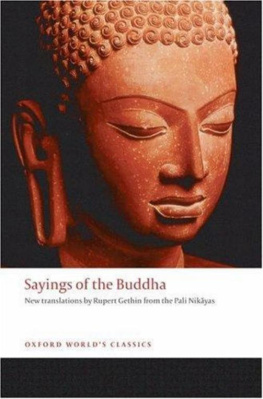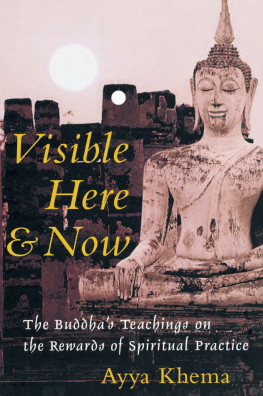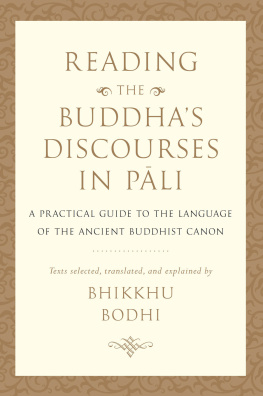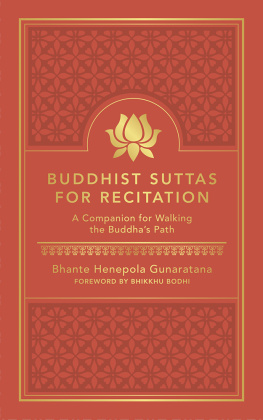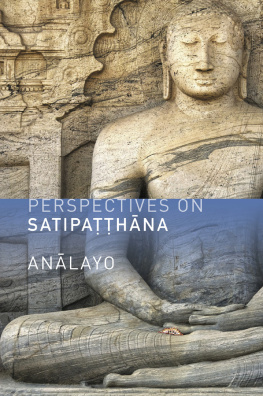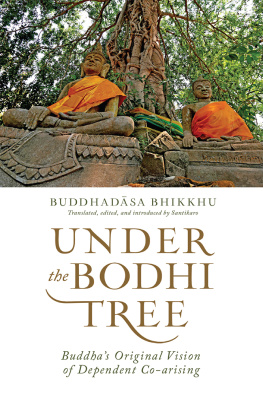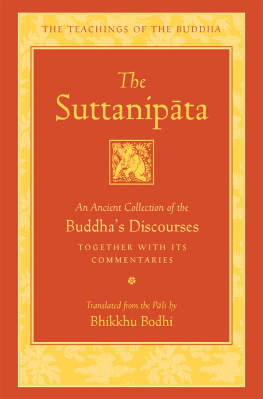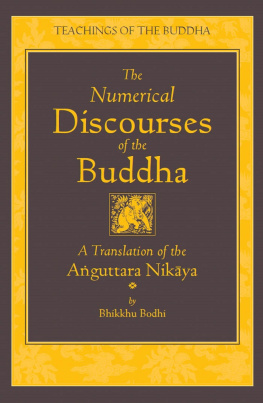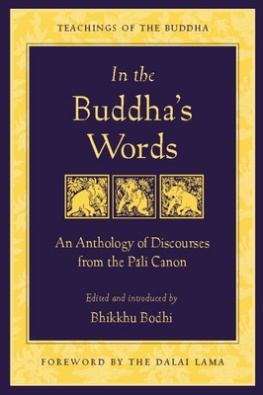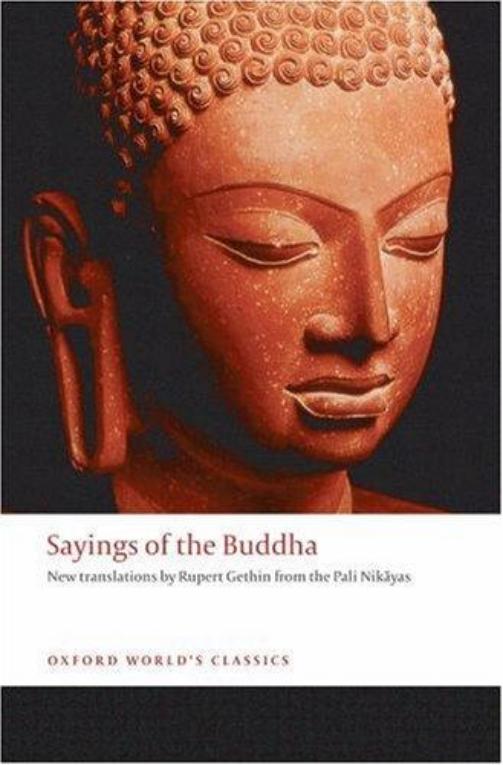Sayings of
the Buddha
A selection of suttas
from the Pali Nikdyas
OXFORD WORLD'S CLASSICS
Translated with an Introduction and Notes
by RUPERT GETHIN
PREFACE
D espite their being some of the oldest and most important Buddhist literary works, the suttas of the Pali Nikayas are not widely known nor generally read (either in translation or the original) beyond Buddhist circles, except perhaps in the context of university courses in Indian or religious studies. I hope that the present volume might go some way to making these striking texts more accessible and familiar to a general readership.
In translating this selection of suttas, I should like to acknowledge the debt I owe to previous scholars and translators generally, but in particular my understanding of Pali texts owes much to conversations with and the published works of Steven Collins, Margaret Cone, L. S. Cousins, Oskar von Hinuber, and K. R. Norman; I am grateful to Mr Norman for answering my queries on several passages, while the first part (a-kh) of Margaret Cone's Dictionary of Pali has been invaluable, and like all scholars of Pali I look forward to the publication of the rest of this dictionary. Over the course of working on these translations I have had many conversations on questions relating to Pali literature with my wife, Rita Langer, and these, as well as her own work on Buddhist funeral rituals, have also fed into my understanding of Pali texts generally and of particular passages. I am also grateful to Ken Robinson, who read through the whole typescript meticulously, pointing out numerous mistakes and making valuable suggestions. Any mistakes that remain, however, are entirely my responsibility. Finally, I would like to thank Judith Luna, the editor of the Oxford World's Classics series, for waiting and also for her quick and judicious advice.
siddhir astu
subham astu
ABBREVIATIONS
Editions of Pali texts (except for Vism) are those now published by the Pali Text Society; dates given are of the first publication of the editions, which are all kept in print by the PTS. Translations (where they exist) are listed in the Select Bibliography.
A Ahguttara-mkdya, 5 vols., ed. R. Morris, A. K. Warder, and
E. Hardy (1885-1900; 2nd edn. of I, 1961) BHSD William Franklin Edgerton, Buddhist Hybrid Sanskrit
Grammar and Dictionary, 2 vols. (New Haven and London,
i953)
CPD V. Trenckner and others, A Critical Pali Dictionary
(Copenhagen, 1924- )
D Digha-nikaya, 3 vols., ed. T. W. Rhys Davids and
J. E. Carpenter (1889-1911)
Dhp-a Dhammapada-atthakatha, ed. H. C. Norman (1906-14)
DOP Margaret Cone, A Dictionary of Pali, Part I, a-kh (Oxford,
2001)
DPPN G. P. Malalasekera, Dictionary of Pali Proper Names, 2 vols.
(London, 1937; repr. 1974)
Ja The Jataka together with its commentary, ed. V. Fausboll
(1877 - 96)
M Majjhima-nikaya, 3 vols., ed. V. Trenckner and R. Chalmers
(1888-1902)
Mil Milindapanho, ed. V. Trenckner (1880; repr. with tika 1961)
Mhv Mahavatnsa, ed. W. Geiger (1908)
Mp Manorathapurani, 5 vols., ed. M. Walleser and H. Kopp
(1924-57) = commentary to A
MW M. Monier-Williams, A Sanskrit-English Dictionary (Oxford,
1899; repr. 1979)
PED T. W. Rhys Davids and William Stede, Pali-English Dictionary
(Chipstead, 1921-5; repr. Oxford, 1999)
Ps Papancasudani, 5 vols., ed. J. H. Woods, D. Kosambi, and
I. B. Horner (1922, 1928, 1933, 1937, 1938) = commentary to M
PTS Pali Text Society
S Samyutta-nikdya, 5 vols., ed. L. Feer (1884, 1888-98)
SBV The Gilgit Manuscript of the Sanghabhedavastu, ed. R. Gnoli
(Rome, 1977)
Skt Sanskrit
Sp Samantapdsddikd, 7 vols., ed. J. Takakusu and M. Nagai
(1924 - 47) = commentary to Vin
Spk Sdratthappakdsini, 3 vols., ed. F. L. Woodward
(1929 - 37) = commentary to S
Sv Sumangalavildsini, 3 vols., ed. T. W. Rhys Davids and
J. E. Carpenter (1929 - 32) = commentary to D
Th i Therigdthd, ed. R. Pischel (1883); 2nd edn., ed. K. R. Norman
and L. Alsdorf (1966).
Vin Vinaya-pitaka, 5 vols., ed. H. Oldenberg (1879-83)
Vism Visuddhimagga, ed. H. C. Warren and D. Kosambi (Cambridge,
Mass., 1950)
INTRODUCTION
T he present volume, entitled Sayings of the Buddha, contains an anthology of ancient Buddhist texts translated from an ancient Indian language known today as Pali. These texts are referred to in Pali as suttas or 'well spoken utterances'.1 They have been selected from the Pali Nikayas, ancient collections of the Buddha's sayings. The Pali Nikayas thus represent examples of Buddhist scriptures, and it might be tempting simply to characterize them as the Buddhist equivalent of the Bible or the Qur'an. And yet unlike, for example, Christianity, Judaism, or Islam, neither Hinduism nor Buddhism has a similarly strictly defined, closed 'canon' of scriptures universally accepted as uniquely authoritative by all those we would wish to call (or who would wish to be called) 'Hindu' or 'Buddhist'. Certainly Hinduism has the Vedas, but as a body of literature these have never been defined as strictly as the Bible or Qur'an.2 Moreover, for different groups of Hindus other collections of scriptures assume a greater significance than the Vedas.3
As for Buddhism, we are faced with the existence of at least three canonical collections of Buddhist scriptures containing 'the word of the Buddha' (buddha-vacana): the Pali canon of 'Three Baskets' (Tipitaka); the Chinese 'Three Baskets' (San zdng) or 'Great Treasury of Sutras' (Ddzdng jing); the Tibetan Kanjur or 'Translated word of the Buddha' (bKa' 'gyur). Each of these canons is authoritative for different traditions of Buddhism: the Pali canon for the Theravada Buddhists of South and South-East Asia (the Buddhists of present-day Sri Lanka, Burma, Thailand, Cambodia, and Laos); the Chinese San zdng for East Asian Buddhists of China, Korea, and Japan; the Tibetan Kanjur for the Buddhists of Tibet and Mongolia.4 While there
The precise meaning of Pali sutta is problematic. Buddhist tradition eventually took it as equivalent to Sanskrit sutra, a word that came to be used to designate concise aphoristic texts, as in Kama-sutra. But it seems more likely that it derives from Sanskrit sukta or 'well said', a term which was used of the ancient verses of the Veda. See K. R. Norman, A Philological Approach to Buddhism, 2nd edn. (Lancaster, 2006), 135.
J. Gonda, Vedic Literature (Wiesbaden, 1975).
So, for example, in the case of a follower of Saiva Siddhanta, it is the twenty-eight Saiva Agamas that constitute the crucial divine revelation of Lord Siva.
Possibly we should include a fourth Buddhist canon, the Sanskrit Nava Grantha or Nava Dharma of Newar Buddhism: Prajnaparamita, Saddharmapunidarika,
is some overlap insofar as one canon might contain versions of certain scriptures contained in another canon, these versions are not straightforward translations into different languages, and it is not possible to identify a universally accepted common core. Moreover, while the Pali canon can be regarded as more or less fixed and closed by the fifth century ce , the Chinese and Tibetan canons have never been formally closed and there is no definitive final list of the works they contain. Certainly the Pali, Chinese, and Tibetan Buddhist canons are all considerably greater in extent than the Christian Bible. The Pali canon comprises twenty-eight works, and printed editions usually fill in the region of forty-five volumes. The older catalogues of the Chinese canon list some 1,500 works, while the modern Taisho edition (1924-32) fills fifty-five volumes, each containing 1,000 pages of Chinese characters, with 2,184 separate works.5 Editions of the Tibetan canon comprise some 700 - 800 works in just over 100 volumes.6 In the case of the Chinese Buddhist canon especially, what we have is not so much a strictly defined canon of scriptures as a library containing all the Chinese translations of Indian Buddhist texts made over the centuries, as well as a variety of indigenous Chinese treatises relating to Buddhism.

